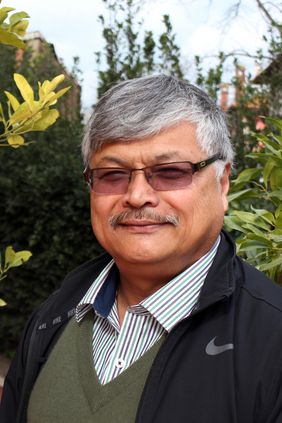- Mr Chetri’s genebank.
- Ruby chocolate. You heard me.
- The next Green Revolution won’t be like the first one. Phew.
- Ideas that will change the world include “super plants” like enset. Right.
- But not, surprisingly, quinoa.
- Or bush tucker.
Sin maíz no hay país
Town by town, I looked for these seeds, studying where they might be located. I started driving to many states in Mexico trying to find them, but there were none. It was so disappointing. One by one, I had people telling me that their grandparents planted them, but not anymore, and they lost the seeds awhile ago… I visited a very old lady who recalled planting them herself, but there was a big frost many years ago that caused her to lose all her seeds. After that, she started buying tortillas.
That’s Rafael Mier on maize in Mexico. But in how many places around the world, and for how many crops, is something similar happening? Perhaps the worst thing about genetic erosion is that we don’t know what we don’t know. But then again, maybe it doesn’t matter, if there are people out there like Rafael doing something about it.
…he was eventually able to find the popcorn seed he needed from a farmer in Mexico state—after planting, it’ll be part of his 2017 personal harvest as well as the first harvest of this variety in 60 years, Mier believes.
Mier believes.
Bhuwon Sthapit RIP
 Very sad to hear a few days ago that Dr Bhuwon Sthapit, a tireless champion of the role of local communities in agrobiodiversity conservation, has died. There’s a lovely tribute on the Bioversity website. And a more formal obituary in the Himalayan Times. Bhuwon was a great guy and an inspirational scientist who leaves behind a massive legacy and a myriad heartbroken friends and colleagues all over the world.
Very sad to hear a few days ago that Dr Bhuwon Sthapit, a tireless champion of the role of local communities in agrobiodiversity conservation, has died. There’s a lovely tribute on the Bioversity website. And a more formal obituary in the Himalayan Times. Bhuwon was a great guy and an inspirational scientist who leaves behind a massive legacy and a myriad heartbroken friends and colleagues all over the world.
Nibbles: Cyprus seeds, Vietnamese rice, Policy briefs, English breakfast tea, Magic mushrooms, Peanut ontology Moccasin Boots, GeoAgro, Zea archaeology, Oenoarchaology, Old ham, ICRISAT genebank, Coffee podcast, ITPGRFA, Amphicarpaea bracteata
- “It is like archaeology to me. When you save an ancient seed it is like saving a sculpture. It represents the culture, tradition and history. Different types have different traits and intense flavours, like tomatoes years ago for example.”
- Vietnamese specialty rices direct from the genebank. Totally unrelated to this NY Times video-essay on Hmong rice farming.
- Time for tea.
- Making coffee good again. Jeremy explores fair trade and Fair Trade. Do tea now, please, Cherfas.
- ‘Shrooms got magic horizontally, man.
- Why do circus peanuts taste of bananas?
- Bringing back the mouse bean. Which may or may not taste of bananas.
- Cool maize book to round off the Native American crops trifecta.
- Oh no, here’s another one. Pinning down maize domestication.
- Funky ICARDA agroclimatological app.
- REALLY old Italian wine. And something to go with it.
- ICRISAT has a genebank in Zimbabwe too.
- Plant Treaty transfers hit a milestone.
- Policy brief on policy briefs. Homework: do a killer policy brief on any of the above.
Brainfood: DNA barcoding, Extremophiles, Chinese wild walnut, Sheep breeders, Argentinian beans, Biobanks QMS, E African seed systems, Apulian vines, People & diversity, Ancient farmers
- Identification of zucchini varieties in commercial food products by DNA typing. You can trace zucchini varieties in food products despite various kinds of processing.
- Anaerobic microorganisms in astrobiological analogue environments: from field site to culture collection. Practicing to collect genetic resources on Mars.
- Genetic diversity and population structure in the narrow endemic Chinese walnut Juglans hopeiensis Hu: implications for conservation. It’s in trouble.
- Do traditional sheep breeders perform conscious selection? An example from a participatory breeding program of Morada Nova sheep. Breeders of purebreds use different criteria to those of crossbreds.
- Characterization of common bean wild populations for their in situ conservation in Northwestern Argentina. Some populations should be conserved because they’re pure wild, the rest because they’re not pure wild.
- Quality Management System for Research Biobanks: a Tool to Incentivize Public-Private Partnerships. ISO developing a QMS specifically for biobanks. Full text in Google Books.
- Cryopreservation of fruit germplasm. Elements of a strategy for Germany.
- Implications of Seed Policies for On-Farm Agro-Biodiversity in Ethiopia and Uganda. 117 provisions in 21 national seed policies in coded for implications for availability and accessibility of improved, quality-controlled and genetically diverse local seed in both the formal and informal seed systems. Ok, now what?
- Measuring the financial sustainability of vine landraces for better conservation programmes of Mediterranean agro-biodiversity. Landraces are not worth it, because of low yields.
- Traditional People, Collectors of Diversity. ‘Nuff said.
- Changes in human skull morphology across the agricultural transition are consistent with softer diets in preindustrial farming groups. Cheese changed your skull shape.